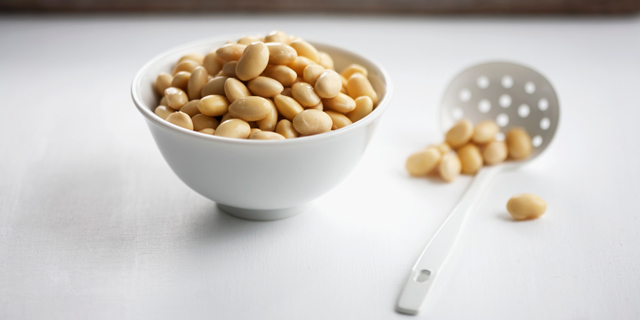A little soy milk with your coffee? Would you prefer a soy burger for lunch? How about some edamame with your sushi? Soybeans and soy products are everywhere, and with that comes a bit of controversy.
While there are many who equate soy with health, there is debate within the nutrition community as to just how healthy soybeans and their products are. The debate that exists has to do with its possible link to breast cancer. Phytoestrogens, chemicals that mimic the behavior of the hormone estrogen and are found in soy products, have been shown to stimulate the growth of breast cancer cells in laboratory experiments. However, when it comes to human studies, the findings are very different; some studies even show a correlation between soy intake and a low incidence of breast cancer.
RELATED: Soy Schnitzel Strips Recipe
The important note on this discussion is that all soy products were not created equal. Most of the soy intake studies that showed a lower risk of breast cancer dealt with the pure form of soy – edamame, tofu, and tempeh, for example. Today we have lots of soy options available and while whole, fresh soybeans are available in most markets, so are other processed foods that use soy protein isolate (SPI) and claim health benefits disproportionate to their actual nutritional consistency.
SPI is a highly refined product that removes most of the carbohydrate and fat from soy flour resulting in a very high protein flour. You can think of soy isolate like refined wheat flour, where many nutrients such as fiber, calcium, and vitamin C are stripped from the soybean during processing. Many products like veggie burgers and soy bars contain SPI. In addition to being a processed food, according to the USDA, over 90% of the soybeans grown in the US are genetically modified.
So if you enjoy your tofu and edamame, the good news is that there is no need to give those soy products up! However, you may want to watch out for SPI and opt for products made with pure soybeans or natural protein sources like lentils, beans, and nuts.
Click on for our quick dictionary of soy goodies!…
[pagebreak]
Pure Soybean Products
Eat these for their high value protein and low fat content.
Edamame
What it is: An immature soybean in the pod that is harvested before it hardens.
How to cook it: Boil, steam, or microwave for a few minutes and sprinkle with salt.
RELATED: Nopales and Fried Tofu in Chipotle Sauce
Tofu (aka Bean Curd)
What it is: A product made by coagulating soy milk and then pressing the curds into soft blocks. How long and intensely the curd is pressed determines the style of the tofu, which ranges from very soft Japanese silken (what is found in miso soup) to the extra firm that can be pan seared.
How to cook it: Simply add the silken variety to soups. Firm tofu needs to be pressed again before cooking. Slice the tofu into half inch slices, set on a paper towel lined platter, and top with more paper towels. Place another platter over the top layer of paper towels and set heavy object like a pot on top. Allow the tofu to press for 30 minutes. At this point you are ready to marinate and cook the tofu. For a quick marinade, mix together: 3 tablespoons low sodium soy sauce, 1/4 cup lime juice, 2-inch piece grated ginger, 1 minced garlic clove, and 1 minced jalapeño.
Tempeh
What is it: Fermented soybeans that are formed into a patty. The fermentation process is responsible for tempeh’s unique tan color and nutty earthy flavor.
How to cook it: Despite its unique flavor, you may still want to marinate tempeh in a bit of soy sauce or dust it with spices. Tempeh can be cut into slices and seared or crumbled into sauces and stews.


![Making Mealtime Matter with La Familia: Easy Sofrito [Video]](https://thelatinkitchen.com/wp-content/uploads/2015/10/sofrito-shutterstock__0-500x383.jpg)
![Easy Latin Smoothies: Goji Berry Smoothie [Video]](https://thelatinkitchen.com/wp-content/uploads/2015/12/goji_berry-shutterstock_-500x383.jpg)
















![Fun and Fast Recipes: Fiesta Cabbage Salad [Video]](https://thelatinkitchen.com/wp-content/uploads/2015/11/fiesta_cabbage_slaw-shutterstock_-500x383.jpg)









